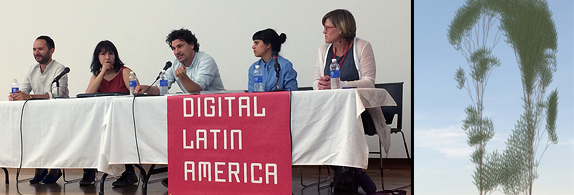
The Digital Latin America Symposium, produced by 516 ARTS in Albuquerque, New Mexico June 7-8, 2014 at the Albuquerque Museum of Art and History, drew creative minds from local communities and diverse places in Latin America. The audience was composed of academics, artists, journalists, community organizers and enthusiasts. 516 ARTS brought together world-renowned artists like Pablo Helguera and Alex Rivera, as well as showcasing talented young artists who bring new concepts and processes to artmaking. This event showed an understanding of the transnational connection that exists between peoples of the Southwest region of the US to peoples, culture and art in Latin America. The symposium created a forum where bright minds engaged in dialogue across physical borders to develop new imaginaries and relationships across vast territories.
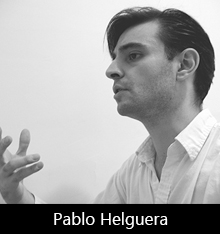 Mexican artist Pablo Helguera’s keynote speech, “Three Chairs for Society” was in tune with the spirit of the symposium when he posed the question – “How do artists become mediators through media?” Helguera provided the historiography of Latin America’s art as seen through a Western lens as exoticized, discredited and viewed as primitive. Latin America has been romanticized and therefore its peoples have been regarded as poets, folk artists and primitive in thought processes instead of as philosophers, scientists, engineers and artists. Helguera pointed out the pressures by Western Thought to commodify Latino culture, and the responsibility that each artist has in his/her decision-making process. These thoughts led him to the creation of his project, “The School of Panamerican Unrest,” for which he set out from a remote location in Alaska to the southernmost point of the continent in Tierra de Fuego, Argentina in search of answers to lifelong questions about the American continent. Helguera’s reflections reveal an insight into Latino and Indigenous culture that is often not seen, heard nor displayed in the world of art or media. He humbly shared his experience to remind the audience that art exists everywhere, in the most remote places, in places of scarcity and in places of hunger. He talked about how people everywhere strive for creativity and aesthetics in non-traditional forms, where they are not compartmentalized by the Western World into the traditional displays in museums. One of his questions was, “What does it mean to live in America?” In his “Che-ian” style journey, he discovered that this question has a multiplicity of answers reflecting a variety of worldviews, perspectives and knowledge that reveal the diversity of the continent.
Mexican artist Pablo Helguera’s keynote speech, “Three Chairs for Society” was in tune with the spirit of the symposium when he posed the question – “How do artists become mediators through media?” Helguera provided the historiography of Latin America’s art as seen through a Western lens as exoticized, discredited and viewed as primitive. Latin America has been romanticized and therefore its peoples have been regarded as poets, folk artists and primitive in thought processes instead of as philosophers, scientists, engineers and artists. Helguera pointed out the pressures by Western Thought to commodify Latino culture, and the responsibility that each artist has in his/her decision-making process. These thoughts led him to the creation of his project, “The School of Panamerican Unrest,” for which he set out from a remote location in Alaska to the southernmost point of the continent in Tierra de Fuego, Argentina in search of answers to lifelong questions about the American continent. Helguera’s reflections reveal an insight into Latino and Indigenous culture that is often not seen, heard nor displayed in the world of art or media. He humbly shared his experience to remind the audience that art exists everywhere, in the most remote places, in places of scarcity and in places of hunger. He talked about how people everywhere strive for creativity and aesthetics in non-traditional forms, where they are not compartmentalized by the Western World into the traditional displays in museums. One of his questions was, “What does it mean to live in America?” In his “Che-ian” style journey, he discovered that this question has a multiplicity of answers reflecting a variety of worldviews, perspectives and knowledge that reveal the diversity of the continent.
 Many of the artists participating in the symposium raised the question of what it means for artists from diverse cultures to use new/digital media. Giselle Beiguelman presented examples from her home country of Brazil, in which artists and everyday people are using digital media as a way to incorporate societal change and cultural transformation in their lives. She presented a motion media piece titled, “Basurama” in which the message of the interactive piece was that the “the city is to be played with” through youth participation. According to Beiguelman, such interactive pieces highlight questions of how media is distributed and how it provides agency to everyday people who are redefining aesthetic principles. The artists presented in the Digital Latin America exhibition at 516 ARTS are looking to push boundaries and concepts to understand not only how technologies become appropriated, but also the ways in which the use of new media can bring cultural transformation across borderlines.
Many of the artists participating in the symposium raised the question of what it means for artists from diverse cultures to use new/digital media. Giselle Beiguelman presented examples from her home country of Brazil, in which artists and everyday people are using digital media as a way to incorporate societal change and cultural transformation in their lives. She presented a motion media piece titled, “Basurama” in which the message of the interactive piece was that the “the city is to be played with” through youth participation. According to Beiguelman, such interactive pieces highlight questions of how media is distributed and how it provides agency to everyday people who are redefining aesthetic principles. The artists presented in the Digital Latin America exhibition at 516 ARTS are looking to push boundaries and concepts to understand not only how technologies become appropriated, but also the ways in which the use of new media can bring cultural transformation across borderlines.
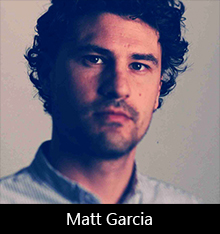 516 ARTS took unconventional approaches at the symposium by creating panels that focused on fields of study that traditionally do not incorporate artwork into their practices, such as STEM-based research, linguistics, ecology and sciences of the cosmos. Researcher and artist Matt Garcia shared two powerful projects exploring traditional Indigenous knowledge of sustainability through the preservation of languages and ecologies as ways of understanding the New Mexican desert region. His work with Tewa Women United aimed at preserving the Tewa language by providing media/technology as resources to facilitate the oral transmittance to future Tewan generations. Through this project, Garcia focused on the importance of language specificity in reference to understanding the region, place and ecology of one’s surroundings. Out of this investigation, Garcia developed a project titled “Desert ARTLab” which used social media networks to generate interest among Albuquerque’s youth to re-plant and replenish plants and ecological traits that bring sustainability to an urban-desert city. The project also helped youth reconnect and understand their surroundings in sustainable ecological ways.
516 ARTS took unconventional approaches at the symposium by creating panels that focused on fields of study that traditionally do not incorporate artwork into their practices, such as STEM-based research, linguistics, ecology and sciences of the cosmos. Researcher and artist Matt Garcia shared two powerful projects exploring traditional Indigenous knowledge of sustainability through the preservation of languages and ecologies as ways of understanding the New Mexican desert region. His work with Tewa Women United aimed at preserving the Tewa language by providing media/technology as resources to facilitate the oral transmittance to future Tewan generations. Through this project, Garcia focused on the importance of language specificity in reference to understanding the region, place and ecology of one’s surroundings. Out of this investigation, Garcia developed a project titled “Desert ARTLab” which used social media networks to generate interest among Albuquerque’s youth to re-plant and replenish plants and ecological traits that bring sustainability to an urban-desert city. The project also helped youth reconnect and understand their surroundings in sustainable ecological ways.
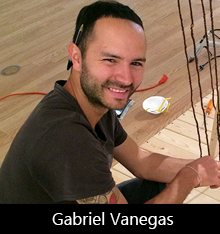 This combining of Indigenous knowledge with new media is also the interest of Colombian artist and academic, Gabriel Vanegas, whose research is focused on uncovering media used in the Americas before the arrival of Europeans as a way to learn from applied knowledge versus the contextualized knowledge detailed in Western books of Indigenous practices. This led to Vanegas’ study of Quipus, Incan communication techniques that used knots in tightly knit ropes as communication modes. His project recreated Quipus in aesthetic representations that combine media and research by compiling interviews conducted with Indigenous communities in Peru in the Quechan language. Vanegas then transmitted this language through a radio in the wires used to form the Quipu as an artistic practice to declare that the Quechua language and traditional Indigenous knowledge continue to live in the Americas.
This combining of Indigenous knowledge with new media is also the interest of Colombian artist and academic, Gabriel Vanegas, whose research is focused on uncovering media used in the Americas before the arrival of Europeans as a way to learn from applied knowledge versus the contextualized knowledge detailed in Western books of Indigenous practices. This led to Vanegas’ study of Quipus, Incan communication techniques that used knots in tightly knit ropes as communication modes. His project recreated Quipus in aesthetic representations that combine media and research by compiling interviews conducted with Indigenous communities in Peru in the Quechan language. Vanegas then transmitted this language through a radio in the wires used to form the Quipu as an artistic practice to declare that the Quechua language and traditional Indigenous knowledge continue to live in the Americas.
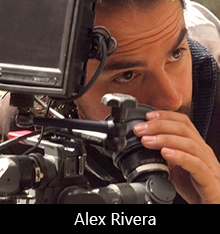 The symposium closed with the keynote speaker and filmmaker, Alex Rivera, who proposed the idea of a “third space” or virtual reality that Latinos inhabit. Rivera argued that the use of media becomes a resource to cope with cultural and physical displacement experienced through patterns of migration. He calls this process, “reverse migration,” a process in which Latinos use media such as television, the Internet, social media (like YouTube or Skype) to reconnect with loved ones, places of origin and culture as a way to feel whole. Through his theories of “reverse migration” and the “third space,” Rivera reveals the power of technology as a resource for healing wounds in the Latino psyche. The process of displacement in migration is what he refers to as “aspects of the transnational condition.” However, he also warns that media and technology can also be used against Latino communities and physical bodies. For Rivera, the US-Mexico border became a testing ground for new technologies making immigrants the test subjects. The physical harm done to migrants in the experimentation of surveillance technology as a way to halt immigration has led Rivera to think about the connection between economics and humane conditions. Rivera uses the image of the cargo freight truck crossing the border detected by x-ray surveillance technology to explain the dynamic of “dead labor” versus “living labor.” He explains “dead labor” as materials or products crossing the border that are “legally” transported to the U.S., while “living labor” or humans (migrants) being transported become “illegal.” The irony is that migrant labor is valued both in the U.S. and in their country of origin, but their physical bodies are “illegal.” Rivera’s theories are crucial to understand the potential of art to reverse oppressive power systems that forget human worth and place value solely on the material.
The symposium closed with the keynote speaker and filmmaker, Alex Rivera, who proposed the idea of a “third space” or virtual reality that Latinos inhabit. Rivera argued that the use of media becomes a resource to cope with cultural and physical displacement experienced through patterns of migration. He calls this process, “reverse migration,” a process in which Latinos use media such as television, the Internet, social media (like YouTube or Skype) to reconnect with loved ones, places of origin and culture as a way to feel whole. Through his theories of “reverse migration” and the “third space,” Rivera reveals the power of technology as a resource for healing wounds in the Latino psyche. The process of displacement in migration is what he refers to as “aspects of the transnational condition.” However, he also warns that media and technology can also be used against Latino communities and physical bodies. For Rivera, the US-Mexico border became a testing ground for new technologies making immigrants the test subjects. The physical harm done to migrants in the experimentation of surveillance technology as a way to halt immigration has led Rivera to think about the connection between economics and humane conditions. Rivera uses the image of the cargo freight truck crossing the border detected by x-ray surveillance technology to explain the dynamic of “dead labor” versus “living labor.” He explains “dead labor” as materials or products crossing the border that are “legally” transported to the U.S., while “living labor” or humans (migrants) being transported become “illegal.” The irony is that migrant labor is valued both in the U.S. and in their country of origin, but their physical bodies are “illegal.” Rivera’s theories are crucial to understand the potential of art to reverse oppressive power systems that forget human worth and place value solely on the material.
Rivera’s final remarks were true to the mission of the Digital Latin America Symposium in asking participants to examine the importance of North and South relations in relation to the responsibilities of the art world. This brief summary of the symposium does not include all panelists or discussions as there were too many to cover here, but rather it aims to capture the spirit and some of the ideas that were shared. The panelists reminded us that there is much aesthetic tradition in Latin America where Indigenous customs and knowledge must be respected and studied as a means to create a better hemisphere and world. The artists showed us that potential exists in the combination of digital artwork with traditional knowledge as a way to both preserve culture and explore new possibilities. With due responsibility, new media/digital artists are pushing the boundaries in redefining what it means to live in the Americas and reinventing the present and possible futures for a better tomorrow.
Selected links & information from the symposium:
-Digital Latin America Symposium Program
-Digital Latin America Artists and Video Sessions
-Peruvian artist Sisa Toaquiza from the presentation “Indigenous Pop: Music and the Digital Presence of Sisa Toaquiza, Flor de los Andes” by Miguel Gandert and Enrique Lamadrid
-“The School of Panamerican Unrest” presented by Pablo Helguera
-“Basurama” by Giszelle Beiguelman
-desert ArtLAB by Mathew Garcia
-Astrovandalistas in the presentation “Territory of the Imagination: Reimagining the Borders of Art and Space”
-“Hemispherical Immersion” by Jessica Angel
-“Sleep Dealer” film interview with Alex Rivera
-516 ARTS website: http://www.516arts.org

July 02, 2014